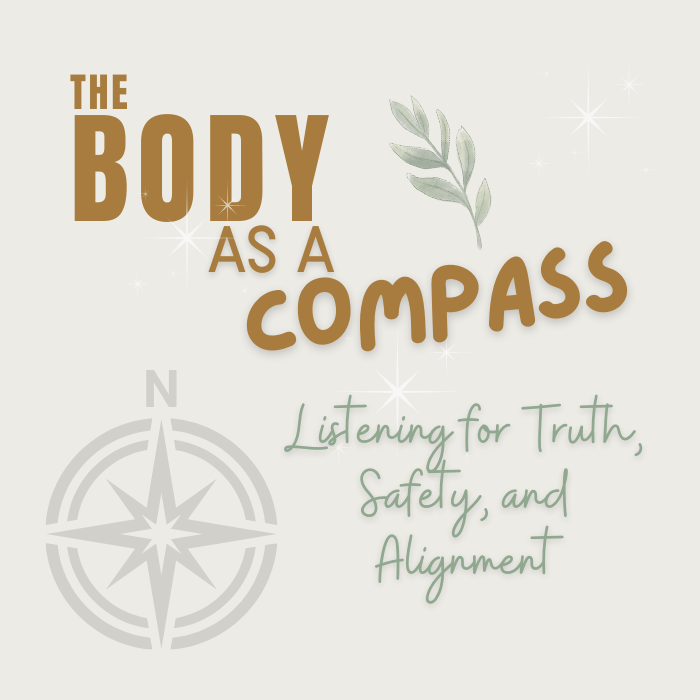A guide to sensing truth, safety, and alignment within
We’re often taught to look outward for answers — to experts, systems, opinions.
But your body holds a quieter intelligence. A knowing that doesn’t shout.
A compass that’s been with you all along.
When you learn to listen to the body, you begin to sense what is true for you, moment by moment.
This isn’t about analyzing every sensation.
It’s about returning to a deep trust:
“My body knows what safety feels like. And I can learn to listen.”
Some links on this page are affiliate links. If you choose to purchase through them, it supports this site at no extra cost to you. Thank you for your support. 🤍
Why the Body Is a Compass
Your body holds more than posture and organs — it holds memory, intuition, and lived experience.
It speaks in:
- Tightness or softness
- Pulls and expansions
- Restlessness, fatigue, tension, or ease
- A subtle “yes” or quiet “no” that isn’t always logical — but feels true to you
These are signals to honor.
When something feels off, the body often senses it before the mind can name it.
When something feels right, the body often softens in relief.
Relearning the Language of the Body
If you grew up needing to override your needs to feel safe or loved, your inner compass may feel foggy. That’s okay… you are re-learning to listen.
Start small.
A simple practice:
- Sit quietly for 2 minutes.
- Ask your body: “How are you feeling right now?”
- Notice without judgment.
A tight jaw? Racing heart? Heavy chest?
Just be with it. - Place a hand somewhere comforting. Breathe. Listen.
- End with a thank-you: “I hear you. Thank you for letting me know.”
This begins to rebuild the trust between you and your internal compass.
Examples of the Compass in Action
✨ A subtle ‘no’ when you’re about to say yes to something that drains you.
✨ A quiet sigh of relief when you’re truly safe.
✨ A sense of being “pulled” toward something that feels aligned, even if it doesn’t make sense.
✨ A sudden constriction around someone’s words, revealing discomfort that your mind hadn’t registered yet.
Your body is always offering information. Always. And it’s up to you if you listen.
What If You Can’t Feel Anything?
Many trauma responses numb us from our bodies. If you feel disconnected,…
Try this:
- Wiggle your toes slowly
- Touch a texture you like (a blanket, a leaf, your shirt)
- Place a hand on your chest or belly and breathe
Let presence come in through sensation, not thought.
Tip:
You can also notice that it’s usually not aligned when your mind starts bringing in justifications, why you should or shouldn’t.
Noticing justification thoughts showing up is a great hint to check in with what is really true for you.
Listening in Everyday Moments
Your body can guide you in small ways, too:
- Pause before making a decision: What softens or tightens? Is your jaw clenched?
- Notice how you feel after spending time with someone
- Tune into your breath when a choice feels unclear
- Let yourself move away from what drains, and lean toward what brings joy or excitement
Over time, this creates a life built on inner alignment — not outer obligation.
🌿 FAQ
How do I know if I’m listening to fear or intuition?
Fear usually feels urgent, tight, loud.
Intuition often feels clear, quiet, and steady. It might lead into the unknown which could bring up tension. Most of us have fear of the unknown, don’t let this throw you.
What if I ignore my body’s signals?
We all override sometimes.
Each time you notice, even afterward, you are growing your awareness. That’s healing.
Next Steps
If this page resonates with you, you might also explore:
- Listening to the Body’s Quiet Signals
- Grounding Practices to Calm the Nervous System
- Working Gently With Resistance
This is not about control.
It’s about partnership — walking with your body instead of against it.
Gentle Support Resources
If you’d like to read more about how the body processes truth and inner knowing, this essay by Hillary McBride may deepen the reflection:
→ What Your Body Knows About Safety
The Wisdom of Your Body by Hillary McBride
A compassionate guide to healing the disconnect between mind and body.
This book speaks directly to the process of listening inward — honoring your body as a source of wisdom, rather than shame.
Vagus Nerve Deck: 75 Exercises to Reset Your Nervous System by Melissa Romano
Practical, body-based prompts to restore inner safety and reconnect with your somatic signals.
Ideal for learning to feel “yes” and “no” more clearly — and for tuning in without overwhelm.
Your unfolding is already underway — and it’s beautiful.

